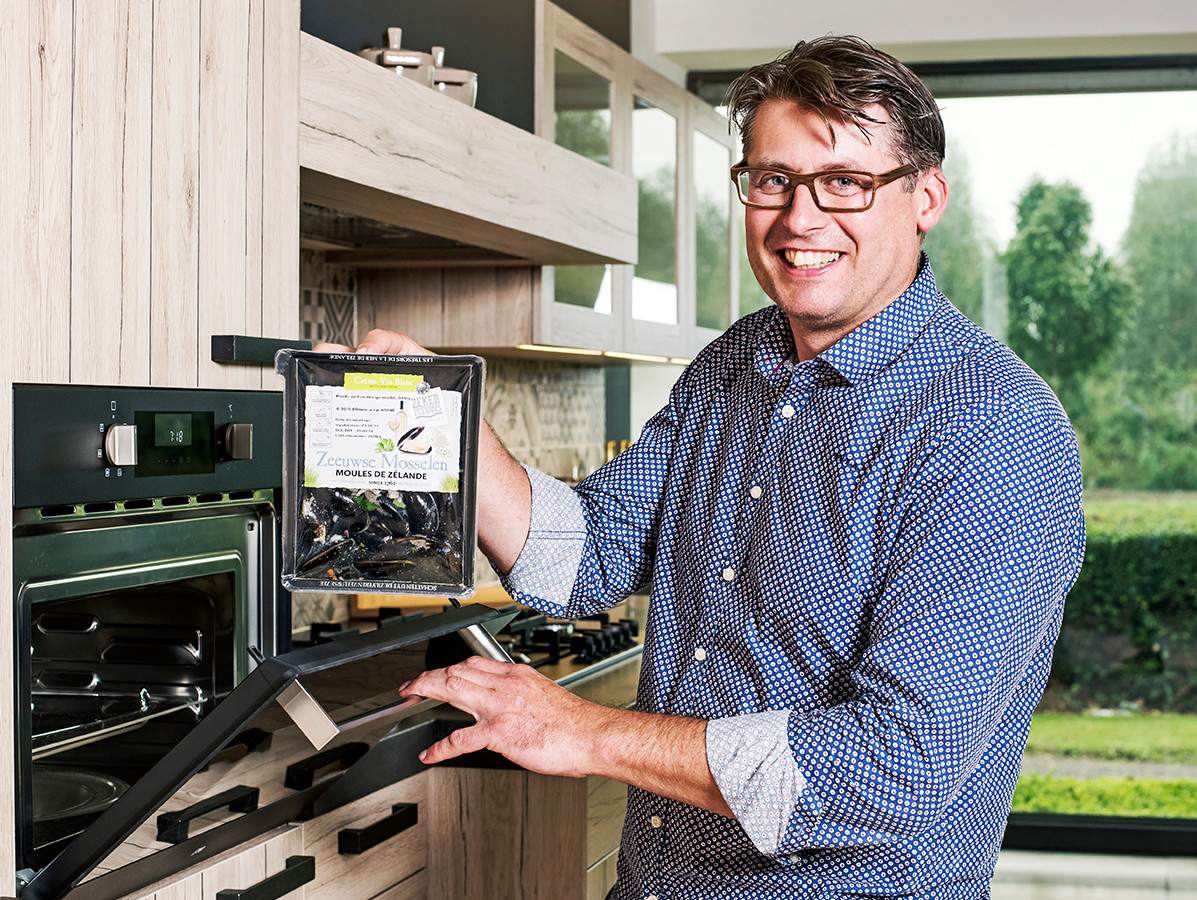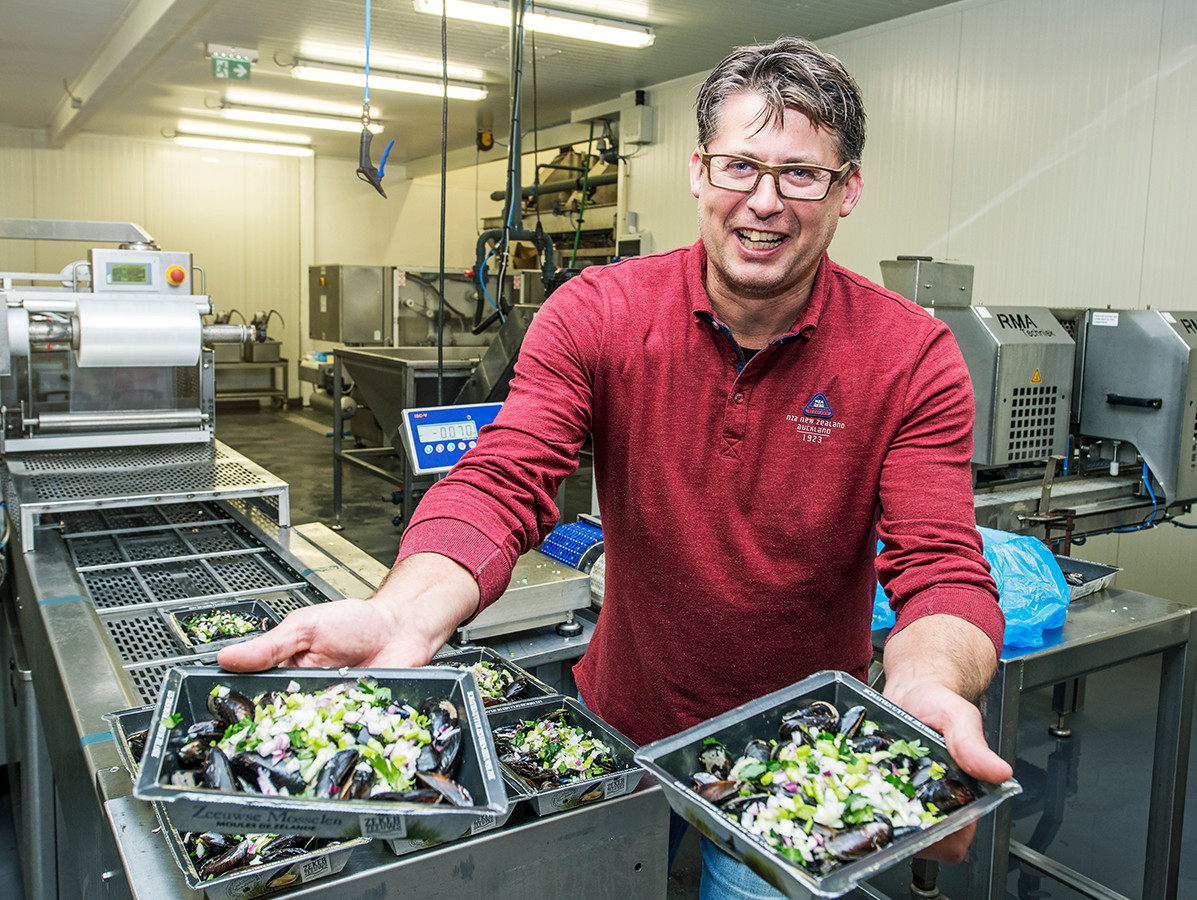
You could call Marko van de Plasse an inventor. He researches, tries, falls and stands up again, to continue experimenting and to find solutions. By doing so new processing and packaging methods are created, aimed at the future and future generations.
Rooted in generations of mussel farmers, and bred and milled in the packaging field, Marko van de Plasse links both worlds to make mussels attractive to new target groups. He threw himself into a new way of preparing mussels: steaming for five minutes in the microwave. Not a unique idea, but difficult to realise for shellfish along with vegetables and herbs.
"My whole family works in the mussel industry. It's in my genes. For years, I worked in the packaging industry. That's how this connection began. The reason: one of my friends got a new kitchen with a steam oven. Then the question arose: what tastes better, steamed or cooked mussels? We tested this by inviting groups of friends and acquaintances to try both. We discovered that steamed mussels taste richer.
Sales of mussels are declining in the market. Consumers are getting older and the industry, including the Dutch Mussel Bureau, is concerned with how we can trigger a younger audience to eat mussels. In any case, they must be tasty, inviting and easy to prepare. There are videos circulating on the internet about how easy it is to prepare mussels; I really wish it were that way. Because no matter how easy it is, people often see the chance to serve them too raw or too cooked which causes them to stop loving mussels.
Steaming is really easy, however, hardly anyone has such an expensive steam oven, while at least eighty percent of households do have a microwave. That's why I started figuring out how to imitate the same steam process in a microwave oven. In principle, the steam process is not unique, but I set the bar very high. I think it's important that every microwave-steamed mussel contains the same amount of meat and in the end I even want to make a restaurant worthy product. Combining mussels, vegetables and spices is extra tricky".
"I started with tests. My knowledge of packaging materials came in handy. I placed mussels in plastic shells and after many tests I learned that they cooked unevenly. From the top they were cooked, from the bottom they remained raw. The pressure level in the packaging has to be perfectly even. Next, I experimented with more flexible packaging. Based on the microwave principle, the pressure distribution will improve that way. Mussels contain water of their own in their shells. You have to heat that water until steam is created. That’s the steam in which the mussels are cooked.”

"The packaging must be both water and gas tight. Four years ago when I started this, I immediately started talking to different buyers from supermarket chains. They already wanted to get rid of plastic, especially for new products. The traditional food industry more often opts for mono-plastics and thinner plastic films, which is already more environmental friendly. It became a quest that resulted in experiments with cardboard trays with a minimal layer of film to seal the packaging completely. Cardboard packaging is still rarely used. It was a challenge to get them gas-tight. We knew it could be done, but mussels give a different gas composition and different reaction than vegetables, for example. After the mussels have been steamed and served, you simply pull the plastic foil off the cardboard. However, cardboard is a lot more expensive than plastic. In terms of price you lose to the competition, but I don't care about that. Because, frankly, there's no one else who makes this product."
"We will continue testing. Next season we'll expand the range to include razor fish, cockles and clams. Then our mussels will also be certified organic. In the end, that requirement from the retail sector has helped us further, your whole mindset has to change. In Belgium, France and Germany in particular, people are very charmed by cardboard packaging".
"That's right. Every mussel is checked. There should be no damaged shell in such a closed package and they should be as equal in weight and size as possible. We also still combine the ingredients manually."
"Fortunately, you can easily add ingredients in cardboard trays. I already came up with a concept: portions of 500 grams in four flavours: natural, marinière, crème au vin blanc and roquefort. At the moment we're working with frozen taste tablets that we add to the packaging. Next season we're ready to scale up, then this process will be far too expensive. The goal is to fill the trays with liquid flavours. It is possible, but we haven't quite finished the process yet."
"That's a challenge. A packaging like that actually has to be foolproof, and it isn't yet. There's a very strong film over the product, because it shouldn't tear. That's disastrous for mussels. For an optimal result you have to puncture the foil twice with a fork before putting it in the microwave. But some people stab through the foil with a knife. Then the holes are too big and the steam process is gone. We are looking for a way for the mussels to release the steam. Albert Heijn has been working with a small valve in the foil of meals for fifteen years. You are not allowed to copy that. There are more solutions, but either they don't work for our foil, or they are not yet on the market. I'm currently testing perforated foil with a label that only loosens under a certain pressure. Not too early, not too late, I want perfection. It will probably take another year before the solution is found, I think."
"I think so. With this concept we are making mussels more accessible and tastier for the consumer. We serve multiple target groups. Think of single elderly people who love mussels but no longer buy them for themselves. 500 grams mussels from the microwave is just right for them. In addition, there are the thirty-somethings who are very health-conscious and enjoy sports. They enjoy eating mussels as snacks during drinks, alongside some cheese. There are also the athletes who follow a protein-rich diet. It is very suitable for them. Finally, I have had various chefs taste it, even at herbal manufacturers. We carried out the same tests as I did four years ago with friends and acquaintances. Stir-frying, cooking and steaming. Steaming wins. A good chef makes a delicious pasta with steamed mussels, razors fish or clams. It takes innovation to win over new generations for these natural products."
Photos:© Impuls Zeeland
Source: © Vakblad Voedingsindustrie 2020